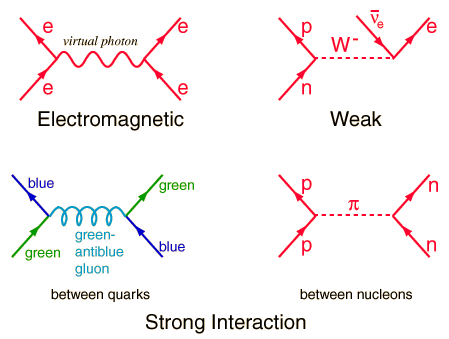Richard Feynman's cartoon squiggles
(From the physics/astronomy department
of Georgia State University,
Atlanta, Georgia USA)
Clicking will make it better.
of Georgia State University,
Atlanta, Georgia USA)
Clicking will make it better.
What's really astonishing about these cartoon squiggles is that they provide our most profound insight into, and our most precise descriptions and predictions of the interactions between the ultimate subatomic forces of which the Universe is composed -- and yet they do so without resorting to even the simplest mathematics.
This is the notation behind the theory of Quantum Electrodynamics (QED), the achievement that won Richard Phillips Feynman the 1965 Nobel Physics Prize, shared with Sin-Itiro Tomonaga and Julian Schwinger. Feynman died on 15 February 1988.
Feynman spent a great part of his career trying to make the great discoveries of modern science accessible to intelligent, curious non-scientists. I'm particularly blown away by "The Character of Physical Law," the book form of a series of popular lectures.
During World War II, Feynman worked at Los Alamos, New Mexico on the Manhattan Project to develop the world's first nuclear bomb, and was present at the first atomic explosion. He claimed to be the only witness to see the explosion directly, looking through a truck windshield to screen out the ultraviolet.
In those days, "computers" were not machines, but human beings, and Feynman supervised Los Alamos' "computers" to solve physics problems which required massive amounts of computation.
As a hobby to break the isolation and boredom at Los Alamos, he tried, usually successfully, to guess the combinations to safes which contained all the atomic secrets. He would leave little ha-ha gotcha notes in the safes he opened and then locked again. A common combination that physicists and mathematicians used at Los Alamos was 27 18 28 because all mathematicians and physicists have memorized the first digits of the pure math constant (named e for Leonhard Euler)
e = 2.718281828 ...
(1828 doesn't repeat after that; that's just a coincidence.)
Feynman loved drumming -- Native-American-style in the New Mexico desert, and later beatnik-style bongo drums.



0 Comments:
Post a Comment
<< Home